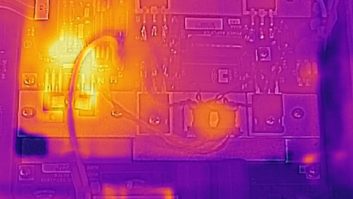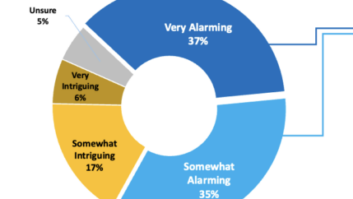(click thumbnail)Fig. 1If you maintain stations and are planning your budget, visit the Web site of Mid-Atlantic Infrared, atwww.midatlanticinfrared.com.
Infrared imaging can be useful for radio. An infrared camera can detect head-related maintenance problems.
Thermal imaging is a visual display of temperature differentials, providing a pictorial presentation of infrared emissions.
(click thumbnail)Fig. 2
These hot spots can give an early warning of impending failure and provide the broadcast engineer with a great diagnostic tool.
Photos from a session in which I was involved demonstrate the effectiveness of infrared imaging. Fig. 1 shows a variable coil inside a phasor. The rotary wheel that taps the coil has corroded.
The inset photo above it shows excessive heat displayed on the right one-third of the coil.
Because this was a stable array, the phasor controls were barely touched. The roller contact on the coil was replaced before damage occurred.
(click thumbnail)Fig. 3
Fig. 2 shows a barrel connection on a line that has overheated. The line was spliced at this point. Even though it’s carrying only 1 kilowatt of RF energy, the image is clear.
Fig. 3 shows that we can spot problems inside transmitters. In this image, loose terminals on the transformer show the potential for failure and fire.
Thermal imaging can be used on rigid transmission lines, spotting split bullets, weak inner connections or bad elbows. We can even see abnormal heat through a transfer switch, by viewing the output ports.
The process is not cheap, but it’s great insurance to prevent catastrophic failure.



. . .
As budget time approaches, here’s a win-win deal for the broadcast engineer, the radio station and the local power utility, offered by Dean Sever.
In addition to doing contract engineering, Sever is an electrical engineer with his local power utility. His proposal requires little or no expense for the station, and can be used as good PR promotion in helping with the energy crunch.
Most power utilities have programs under the name of load management or interruptible rates that offer utility bill credits, reductions or rebates if the utility is allowed to control loads at a business during times of energy shortages. On the average, these load management events occur three to four times a month for periods of two to three hours.
The utility will install, free of charge, a device called a Load Control Receiver. The LCR normally is controlled by a paging-type radio signal that originates from the utility, although leased-line, satellite and FM subcarrier signals can be used.
This device provides a momentary or latching relay that will disconnect a load or source. We’re probably most familiar with the use of these devices on home water heaters.
The LCR also can be used to trigger a transfer switch on a generator. Herein lies the benefit for the radio station.
When connected to the generator transfer switch, the generator can be energized and “tested” online periodically during heavy load periods.
The service is free; the engineer benefits from periodic full-load testing of his generator; and the station receives a credit on its power bill while helping with the energy crunch.
. . .
Dan Case, director of engineering for Citadel Little Rock, was refurbishing some yellowed telephone sets and sought a way to restore the plastic housings to their original white.
Querying Dave Biondi’s Radio-Tech listserv at [email protected] brought a suggestion to try CLR Cleaner brand, found at Wal-Mart or similar stores.
Aaron Read, an associate Webcast producer, says this cleaner will clean almost anything. Its ingredients include a mild acid, so use caution, but it’s just the answer for removing this kind of grime.
Read recommends you rinse the plastic housing thoroughly, and use the product in a well-ventilated area.
. . .
Speaking of telephones and related devices, Ray Vaughn is a ham and a CBTE. He offered the following Web site to Radio-Tech readers. We’d like to share it with readers of Workbench who are looking for some interesting telephone related devices.
It’s www.vikingelectronics.com. You’ll find a variety of telephone accessories including an inexpensive voice coupler, the RAD-1.
. . .
Awhile back, I wrote about the Nigerian scams – remember, “Send us your bank account so we can wire transfer large sums of money to you,” meantime they wipe out your bank account!
Steven Dahlman, who spent 15 years in radio before moving into software development and photography (www.dcmsoft.com and www.dcmsoft.com/photo) has a site that exposes these Nigerian scams.
Steven writes that it’s bigger than we think! The site can be reached at www.tankozuba.com. As an aside, he still reads Radio World – proof you’ll never get radio out of your system.
Submissions for this column are encouraged, and qualify for SBE recertification credit. Fax your submission to (703) 323-8044, or send e-mail to[email protected].












